Business Strategy Report
VerifiedAdded on 2020/12/09
|14
|3934
|137
Report
AI Summary
This report analyzes the business strategy of Marks and Spencer, a leading UK retailer. It examines the impact of the macro environment, evaluates the internal environment, applies Porter's Five Forces model, and recommends a strategic plan based on Ansoff matrix and STP model.
Contribute Materials
Your contribution can guide someone’s learning journey. Share your
documents today.
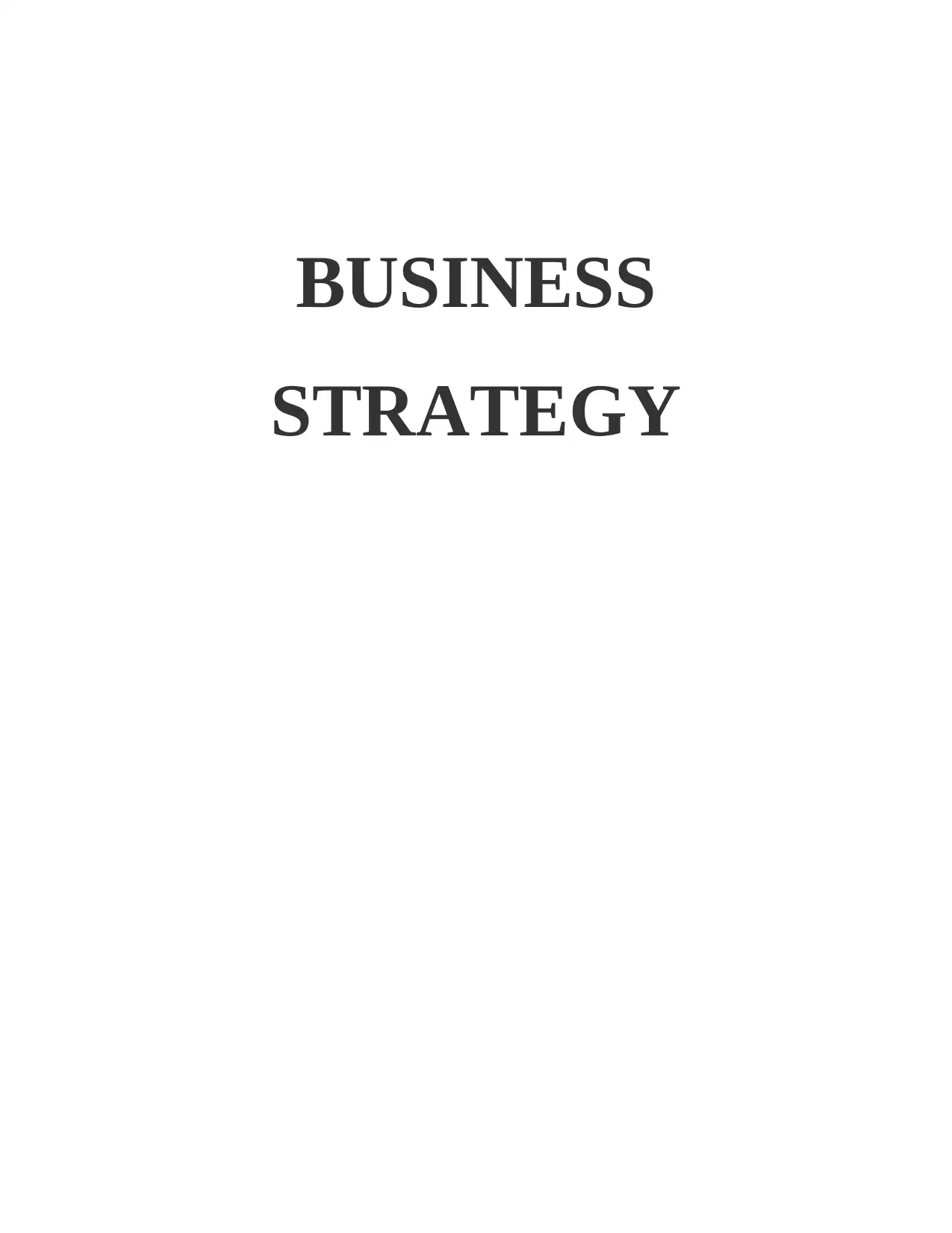
BUSINESS
STRATEGY
STRATEGY
Secure Best Marks with AI Grader
Need help grading? Try our AI Grader for instant feedback on your assignments.
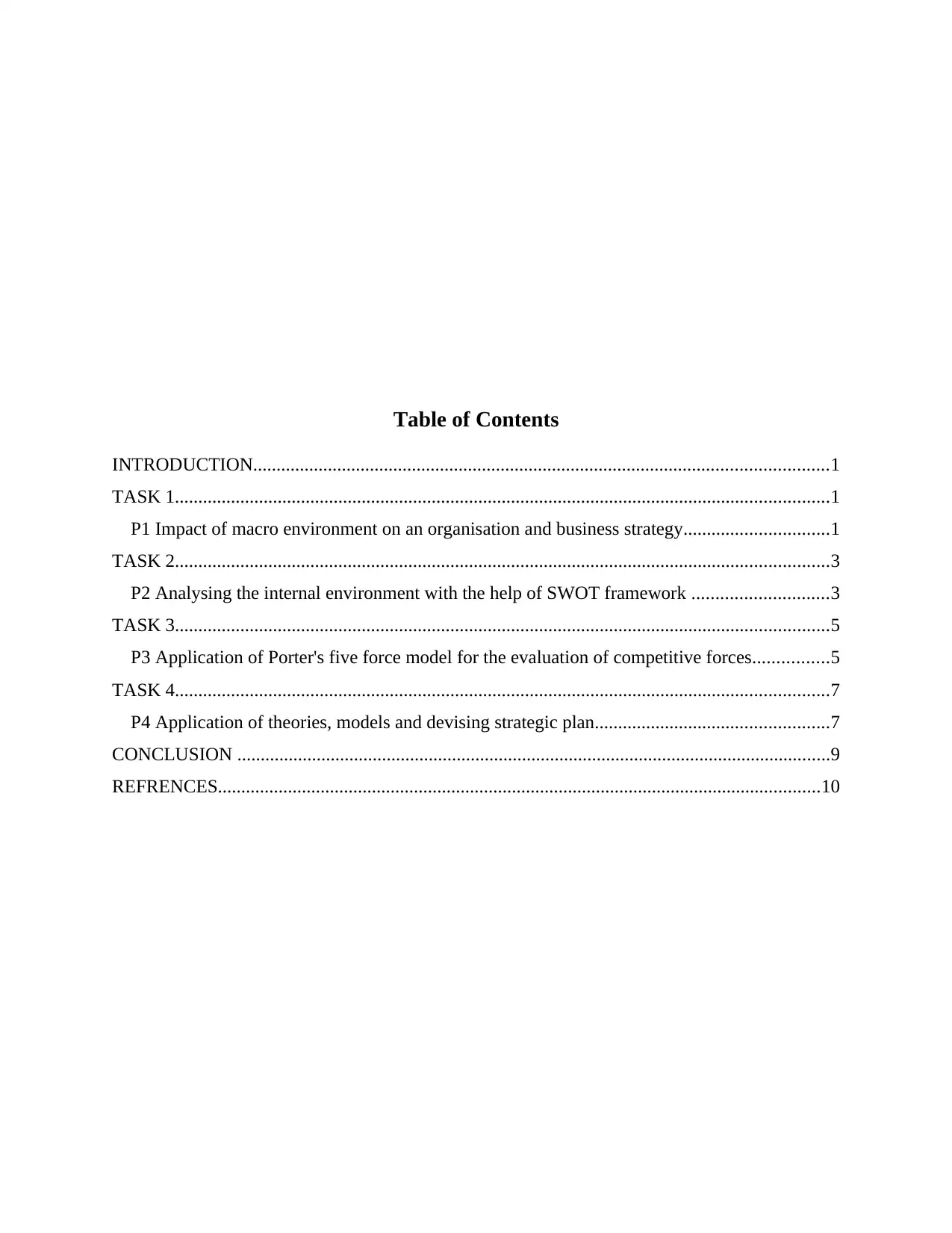
Table of Contents
INTRODUCTION...........................................................................................................................1
TASK 1............................................................................................................................................1
P1 Impact of macro environment on an organisation and business strategy...............................1
TASK 2............................................................................................................................................3
P2 Analysing the internal environment with the help of SWOT framework .............................3
TASK 3............................................................................................................................................5
P3 Application of Porter's five force model for the evaluation of competitive forces................5
TASK 4............................................................................................................................................7
P4 Application of theories, models and devising strategic plan..................................................7
CONCLUSION ...............................................................................................................................9
REFRENCES.................................................................................................................................10
INTRODUCTION...........................................................................................................................1
TASK 1............................................................................................................................................1
P1 Impact of macro environment on an organisation and business strategy...............................1
TASK 2............................................................................................................................................3
P2 Analysing the internal environment with the help of SWOT framework .............................3
TASK 3............................................................................................................................................5
P3 Application of Porter's five force model for the evaluation of competitive forces................5
TASK 4............................................................................................................................................7
P4 Application of theories, models and devising strategic plan..................................................7
CONCLUSION ...............................................................................................................................9
REFRENCES.................................................................................................................................10

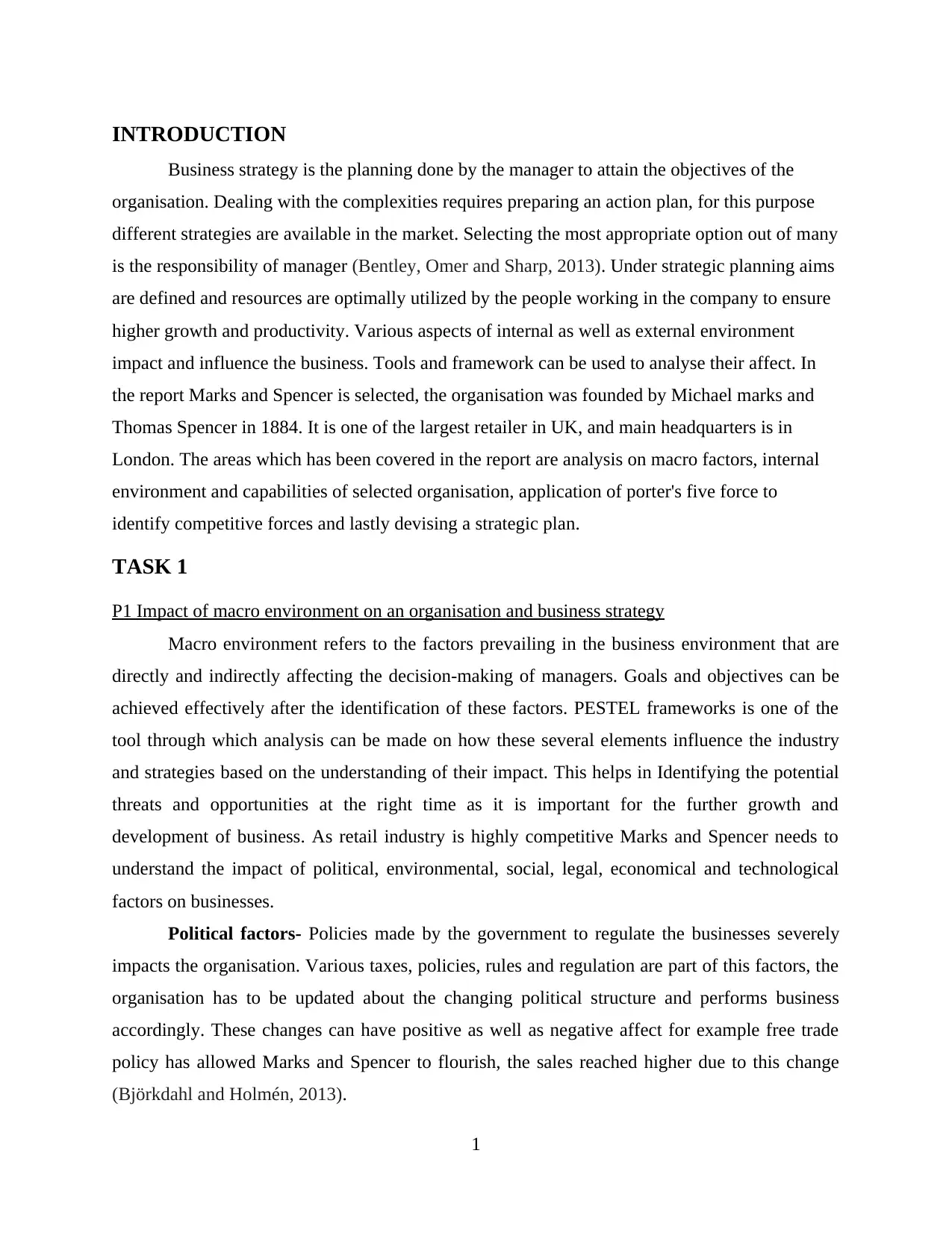
INTRODUCTION
Business strategy is the planning done by the manager to attain the objectives of the
organisation. Dealing with the complexities requires preparing an action plan, for this purpose
different strategies are available in the market. Selecting the most appropriate option out of many
is the responsibility of manager (Bentley, Omer and Sharp, 2013). Under strategic planning aims
are defined and resources are optimally utilized by the people working in the company to ensure
higher growth and productivity. Various aspects of internal as well as external environment
impact and influence the business. Tools and framework can be used to analyse their affect. In
the report Marks and Spencer is selected, the organisation was founded by Michael marks and
Thomas Spencer in 1884. It is one of the largest retailer in UK, and main headquarters is in
London. The areas which has been covered in the report are analysis on macro factors, internal
environment and capabilities of selected organisation, application of porter's five force to
identify competitive forces and lastly devising a strategic plan.
TASK 1
P1 Impact of macro environment on an organisation and business strategy
Macro environment refers to the factors prevailing in the business environment that are
directly and indirectly affecting the decision-making of managers. Goals and objectives can be
achieved effectively after the identification of these factors. PESTEL frameworks is one of the
tool through which analysis can be made on how these several elements influence the industry
and strategies based on the understanding of their impact. This helps in Identifying the potential
threats and opportunities at the right time as it is important for the further growth and
development of business. As retail industry is highly competitive Marks and Spencer needs to
understand the impact of political, environmental, social, legal, economical and technological
factors on businesses.
Political factors- Policies made by the government to regulate the businesses severely
impacts the organisation. Various taxes, policies, rules and regulation are part of this factors, the
organisation has to be updated about the changing political structure and performs business
accordingly. These changes can have positive as well as negative affect for example free trade
policy has allowed Marks and Spencer to flourish, the sales reached higher due to this change
(Björkdahl and Holmén, 2013).
1
Business strategy is the planning done by the manager to attain the objectives of the
organisation. Dealing with the complexities requires preparing an action plan, for this purpose
different strategies are available in the market. Selecting the most appropriate option out of many
is the responsibility of manager (Bentley, Omer and Sharp, 2013). Under strategic planning aims
are defined and resources are optimally utilized by the people working in the company to ensure
higher growth and productivity. Various aspects of internal as well as external environment
impact and influence the business. Tools and framework can be used to analyse their affect. In
the report Marks and Spencer is selected, the organisation was founded by Michael marks and
Thomas Spencer in 1884. It is one of the largest retailer in UK, and main headquarters is in
London. The areas which has been covered in the report are analysis on macro factors, internal
environment and capabilities of selected organisation, application of porter's five force to
identify competitive forces and lastly devising a strategic plan.
TASK 1
P1 Impact of macro environment on an organisation and business strategy
Macro environment refers to the factors prevailing in the business environment that are
directly and indirectly affecting the decision-making of managers. Goals and objectives can be
achieved effectively after the identification of these factors. PESTEL frameworks is one of the
tool through which analysis can be made on how these several elements influence the industry
and strategies based on the understanding of their impact. This helps in Identifying the potential
threats and opportunities at the right time as it is important for the further growth and
development of business. As retail industry is highly competitive Marks and Spencer needs to
understand the impact of political, environmental, social, legal, economical and technological
factors on businesses.
Political factors- Policies made by the government to regulate the businesses severely
impacts the organisation. Various taxes, policies, rules and regulation are part of this factors, the
organisation has to be updated about the changing political structure and performs business
accordingly. These changes can have positive as well as negative affect for example free trade
policy has allowed Marks and Spencer to flourish, the sales reached higher due to this change
(Björkdahl and Holmén, 2013).
1
Secure Best Marks with AI Grader
Need help grading? Try our AI Grader for instant feedback on your assignments.
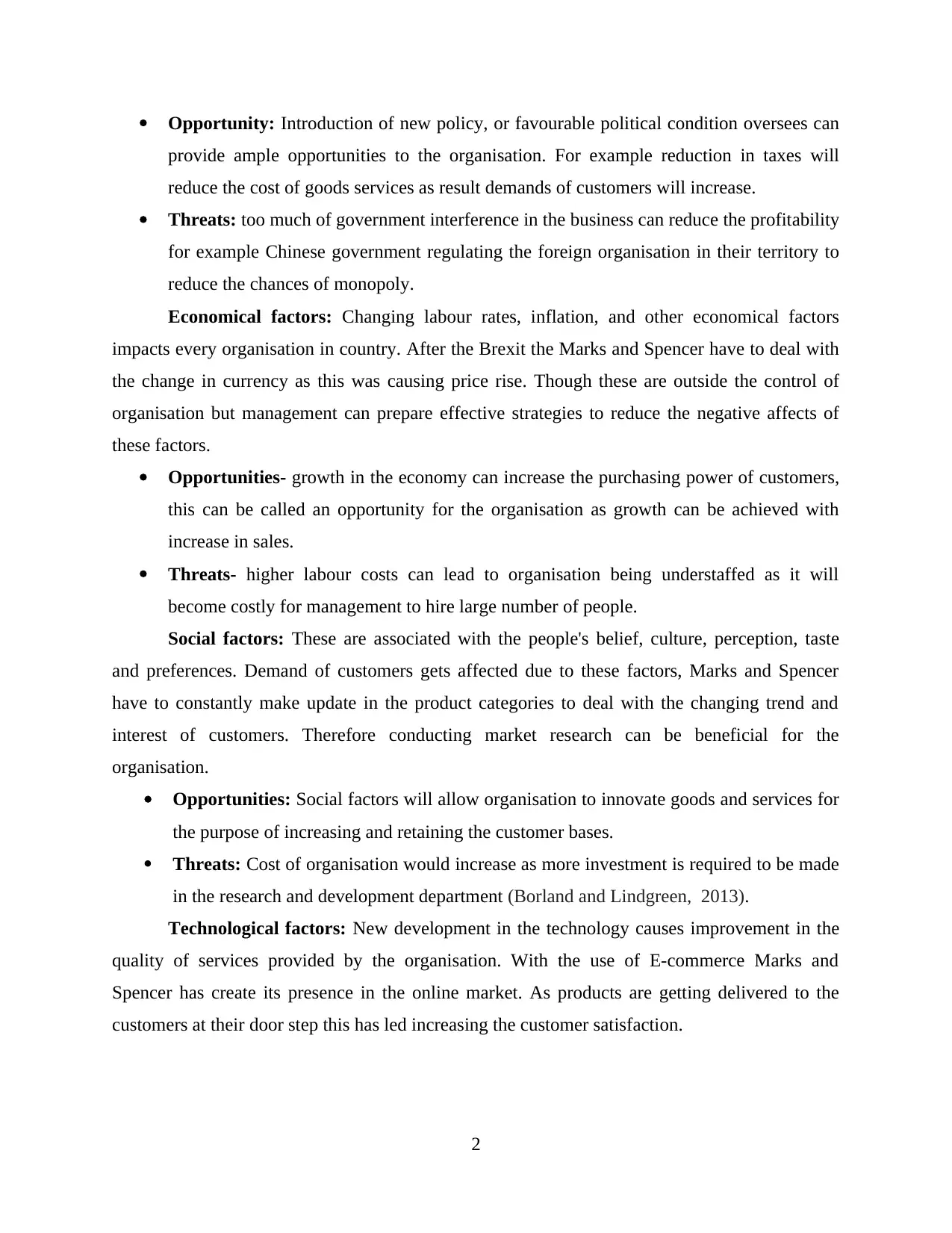
Opportunity: Introduction of new policy, or favourable political condition oversees can
provide ample opportunities to the organisation. For example reduction in taxes will
reduce the cost of goods services as result demands of customers will increase.
Threats: too much of government interference in the business can reduce the profitability
for example Chinese government regulating the foreign organisation in their territory to
reduce the chances of monopoly.
Economical factors: Changing labour rates, inflation, and other economical factors
impacts every organisation in country. After the Brexit the Marks and Spencer have to deal with
the change in currency as this was causing price rise. Though these are outside the control of
organisation but management can prepare effective strategies to reduce the negative affects of
these factors.
Opportunities- growth in the economy can increase the purchasing power of customers,
this can be called an opportunity for the organisation as growth can be achieved with
increase in sales.
Threats- higher labour costs can lead to organisation being understaffed as it will
become costly for management to hire large number of people.
Social factors: These are associated with the people's belief, culture, perception, taste
and preferences. Demand of customers gets affected due to these factors, Marks and Spencer
have to constantly make update in the product categories to deal with the changing trend and
interest of customers. Therefore conducting market research can be beneficial for the
organisation.
Opportunities: Social factors will allow organisation to innovate goods and services for
the purpose of increasing and retaining the customer bases.
Threats: Cost of organisation would increase as more investment is required to be made
in the research and development department (Borland and Lindgreen, 2013).
Technological factors: New development in the technology causes improvement in the
quality of services provided by the organisation. With the use of E-commerce Marks and
Spencer has create its presence in the online market. As products are getting delivered to the
customers at their door step this has led increasing the customer satisfaction.
2
provide ample opportunities to the organisation. For example reduction in taxes will
reduce the cost of goods services as result demands of customers will increase.
Threats: too much of government interference in the business can reduce the profitability
for example Chinese government regulating the foreign organisation in their territory to
reduce the chances of monopoly.
Economical factors: Changing labour rates, inflation, and other economical factors
impacts every organisation in country. After the Brexit the Marks and Spencer have to deal with
the change in currency as this was causing price rise. Though these are outside the control of
organisation but management can prepare effective strategies to reduce the negative affects of
these factors.
Opportunities- growth in the economy can increase the purchasing power of customers,
this can be called an opportunity for the organisation as growth can be achieved with
increase in sales.
Threats- higher labour costs can lead to organisation being understaffed as it will
become costly for management to hire large number of people.
Social factors: These are associated with the people's belief, culture, perception, taste
and preferences. Demand of customers gets affected due to these factors, Marks and Spencer
have to constantly make update in the product categories to deal with the changing trend and
interest of customers. Therefore conducting market research can be beneficial for the
organisation.
Opportunities: Social factors will allow organisation to innovate goods and services for
the purpose of increasing and retaining the customer bases.
Threats: Cost of organisation would increase as more investment is required to be made
in the research and development department (Borland and Lindgreen, 2013).
Technological factors: New development in the technology causes improvement in the
quality of services provided by the organisation. With the use of E-commerce Marks and
Spencer has create its presence in the online market. As products are getting delivered to the
customers at their door step this has led increasing the customer satisfaction.
2
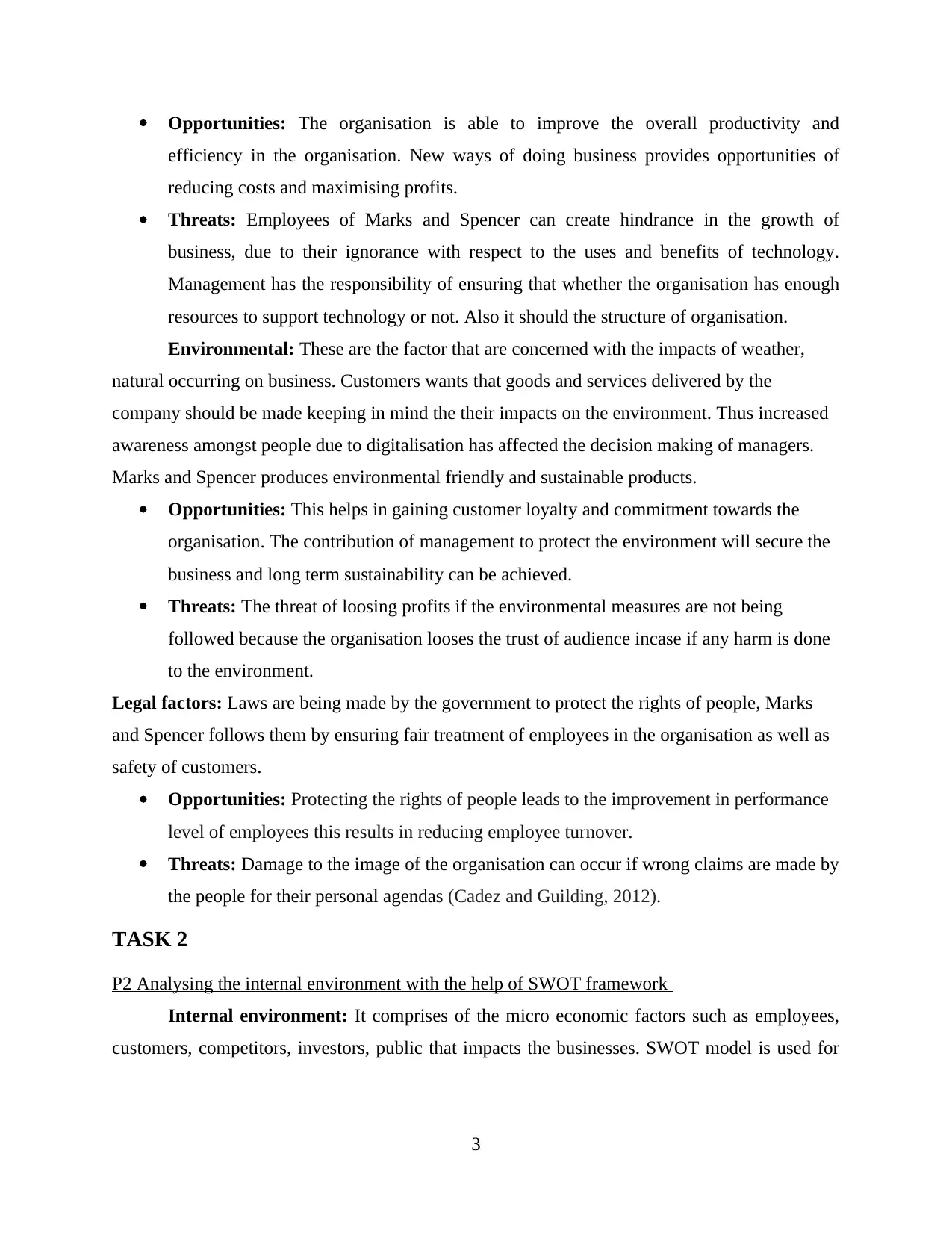
Opportunities: The organisation is able to improve the overall productivity and
efficiency in the organisation. New ways of doing business provides opportunities of
reducing costs and maximising profits.
Threats: Employees of Marks and Spencer can create hindrance in the growth of
business, due to their ignorance with respect to the uses and benefits of technology.
Management has the responsibility of ensuring that whether the organisation has enough
resources to support technology or not. Also it should the structure of organisation.
Environmental: These are the factor that are concerned with the impacts of weather,
natural occurring on business. Customers wants that goods and services delivered by the
company should be made keeping in mind the their impacts on the environment. Thus increased
awareness amongst people due to digitalisation has affected the decision making of managers.
Marks and Spencer produces environmental friendly and sustainable products.
Opportunities: This helps in gaining customer loyalty and commitment towards the
organisation. The contribution of management to protect the environment will secure the
business and long term sustainability can be achieved.
Threats: The threat of loosing profits if the environmental measures are not being
followed because the organisation looses the trust of audience incase if any harm is done
to the environment.
Legal factors: Laws are being made by the government to protect the rights of people, Marks
and Spencer follows them by ensuring fair treatment of employees in the organisation as well as
safety of customers.
Opportunities: Protecting the rights of people leads to the improvement in performance
level of employees this results in reducing employee turnover.
Threats: Damage to the image of the organisation can occur if wrong claims are made by
the people for their personal agendas (Cadez and Guilding, 2012).
TASK 2
P2 Analysing the internal environment with the help of SWOT framework
Internal environment: It comprises of the micro economic factors such as employees,
customers, competitors, investors, public that impacts the businesses. SWOT model is used for
3
efficiency in the organisation. New ways of doing business provides opportunities of
reducing costs and maximising profits.
Threats: Employees of Marks and Spencer can create hindrance in the growth of
business, due to their ignorance with respect to the uses and benefits of technology.
Management has the responsibility of ensuring that whether the organisation has enough
resources to support technology or not. Also it should the structure of organisation.
Environmental: These are the factor that are concerned with the impacts of weather,
natural occurring on business. Customers wants that goods and services delivered by the
company should be made keeping in mind the their impacts on the environment. Thus increased
awareness amongst people due to digitalisation has affected the decision making of managers.
Marks and Spencer produces environmental friendly and sustainable products.
Opportunities: This helps in gaining customer loyalty and commitment towards the
organisation. The contribution of management to protect the environment will secure the
business and long term sustainability can be achieved.
Threats: The threat of loosing profits if the environmental measures are not being
followed because the organisation looses the trust of audience incase if any harm is done
to the environment.
Legal factors: Laws are being made by the government to protect the rights of people, Marks
and Spencer follows them by ensuring fair treatment of employees in the organisation as well as
safety of customers.
Opportunities: Protecting the rights of people leads to the improvement in performance
level of employees this results in reducing employee turnover.
Threats: Damage to the image of the organisation can occur if wrong claims are made by
the people for their personal agendas (Cadez and Guilding, 2012).
TASK 2
P2 Analysing the internal environment with the help of SWOT framework
Internal environment: It comprises of the micro economic factors such as employees,
customers, competitors, investors, public that impacts the businesses. SWOT model is used for
3
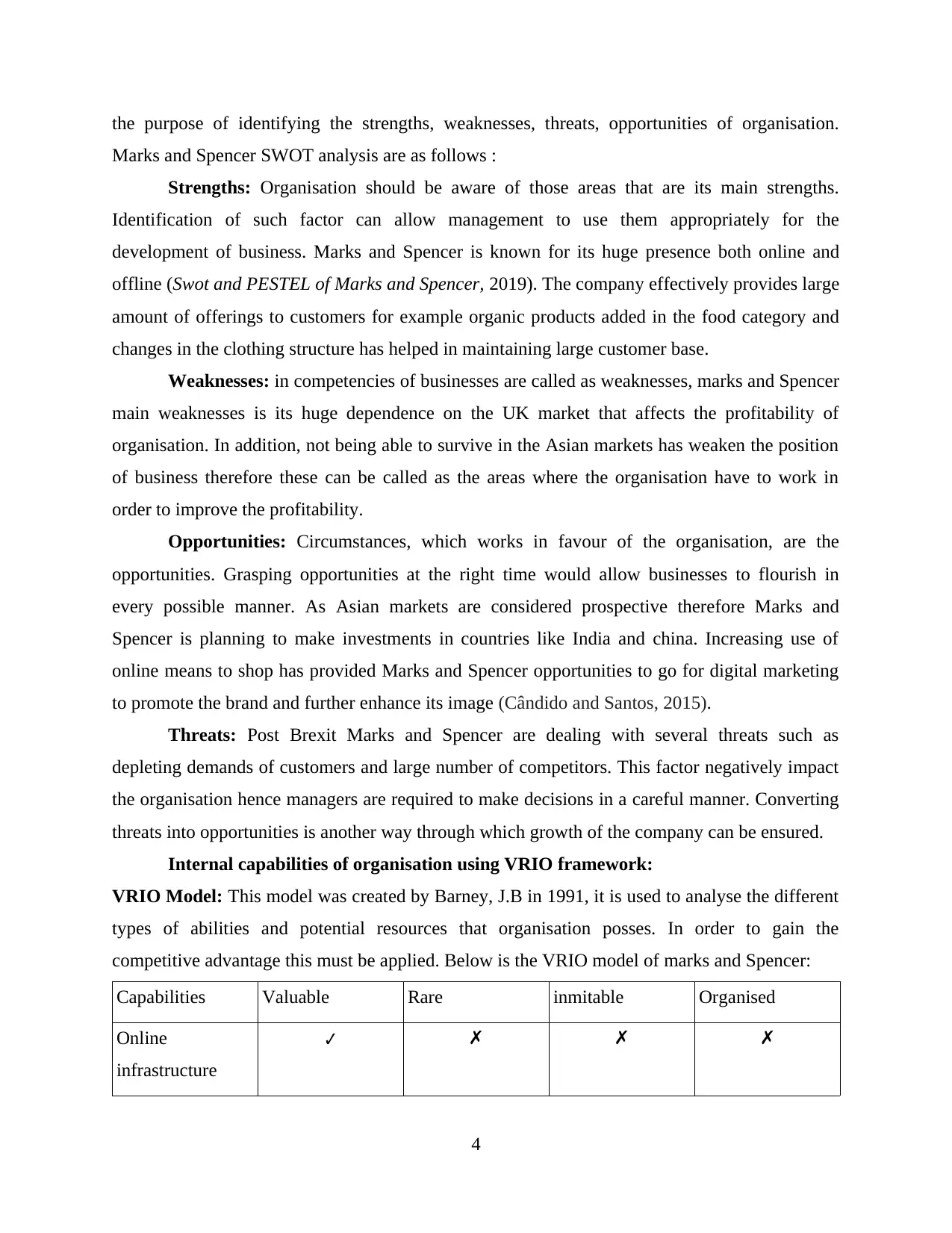
the purpose of identifying the strengths, weaknesses, threats, opportunities of organisation.
Marks and Spencer SWOT analysis are as follows :
Strengths: Organisation should be aware of those areas that are its main strengths.
Identification of such factor can allow management to use them appropriately for the
development of business. Marks and Spencer is known for its huge presence both online and
offline (Swot and PESTEL of Marks and Spencer, 2019). The company effectively provides large
amount of offerings to customers for example organic products added in the food category and
changes in the clothing structure has helped in maintaining large customer base.
Weaknesses: in competencies of businesses are called as weaknesses, marks and Spencer
main weaknesses is its huge dependence on the UK market that affects the profitability of
organisation. In addition, not being able to survive in the Asian markets has weaken the position
of business therefore these can be called as the areas where the organisation have to work in
order to improve the profitability.
Opportunities: Circumstances, which works in favour of the organisation, are the
opportunities. Grasping opportunities at the right time would allow businesses to flourish in
every possible manner. As Asian markets are considered prospective therefore Marks and
Spencer is planning to make investments in countries like India and china. Increasing use of
online means to shop has provided Marks and Spencer opportunities to go for digital marketing
to promote the brand and further enhance its image (Cândido and Santos, 2015).
Threats: Post Brexit Marks and Spencer are dealing with several threats such as
depleting demands of customers and large number of competitors. This factor negatively impact
the organisation hence managers are required to make decisions in a careful manner. Converting
threats into opportunities is another way through which growth of the company can be ensured.
Internal capabilities of organisation using VRIO framework:
VRIO Model: This model was created by Barney, J.B in 1991, it is used to analyse the different
types of abilities and potential resources that organisation posses. In order to gain the
competitive advantage this must be applied. Below is the VRIO model of marks and Spencer:
Capabilities Valuable Rare inmitable Organised
Online
infrastructure
✔ ✗ ✗ ✗
4
Marks and Spencer SWOT analysis are as follows :
Strengths: Organisation should be aware of those areas that are its main strengths.
Identification of such factor can allow management to use them appropriately for the
development of business. Marks and Spencer is known for its huge presence both online and
offline (Swot and PESTEL of Marks and Spencer, 2019). The company effectively provides large
amount of offerings to customers for example organic products added in the food category and
changes in the clothing structure has helped in maintaining large customer base.
Weaknesses: in competencies of businesses are called as weaknesses, marks and Spencer
main weaknesses is its huge dependence on the UK market that affects the profitability of
organisation. In addition, not being able to survive in the Asian markets has weaken the position
of business therefore these can be called as the areas where the organisation have to work in
order to improve the profitability.
Opportunities: Circumstances, which works in favour of the organisation, are the
opportunities. Grasping opportunities at the right time would allow businesses to flourish in
every possible manner. As Asian markets are considered prospective therefore Marks and
Spencer is planning to make investments in countries like India and china. Increasing use of
online means to shop has provided Marks and Spencer opportunities to go for digital marketing
to promote the brand and further enhance its image (Cândido and Santos, 2015).
Threats: Post Brexit Marks and Spencer are dealing with several threats such as
depleting demands of customers and large number of competitors. This factor negatively impact
the organisation hence managers are required to make decisions in a careful manner. Converting
threats into opportunities is another way through which growth of the company can be ensured.
Internal capabilities of organisation using VRIO framework:
VRIO Model: This model was created by Barney, J.B in 1991, it is used to analyse the different
types of abilities and potential resources that organisation posses. In order to gain the
competitive advantage this must be applied. Below is the VRIO model of marks and Spencer:
Capabilities Valuable Rare inmitable Organised
Online
infrastructure
✔ ✗ ✗ ✗
4
Paraphrase This Document
Need a fresh take? Get an instant paraphrase of this document with our AI Paraphraser
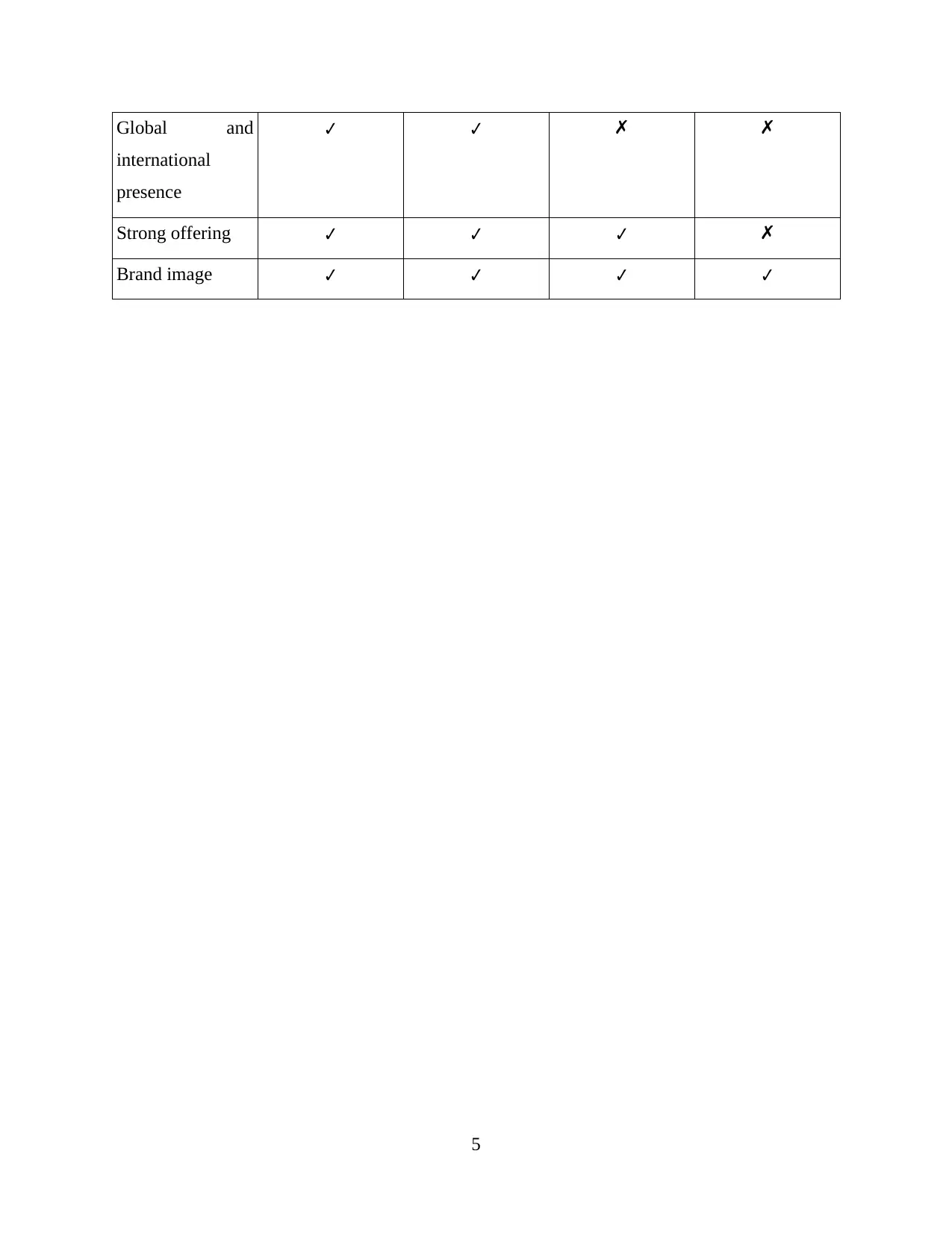
Global and
international
presence
✔ ✔ ✗ ✗
Strong offering ✔ ✔ ✔ ✗
Brand image ✔ ✔ ✔ ✔
5
international
presence
✔ ✔ ✗ ✗
Strong offering ✔ ✔ ✔ ✗
Brand image ✔ ✔ ✔ ✔
5
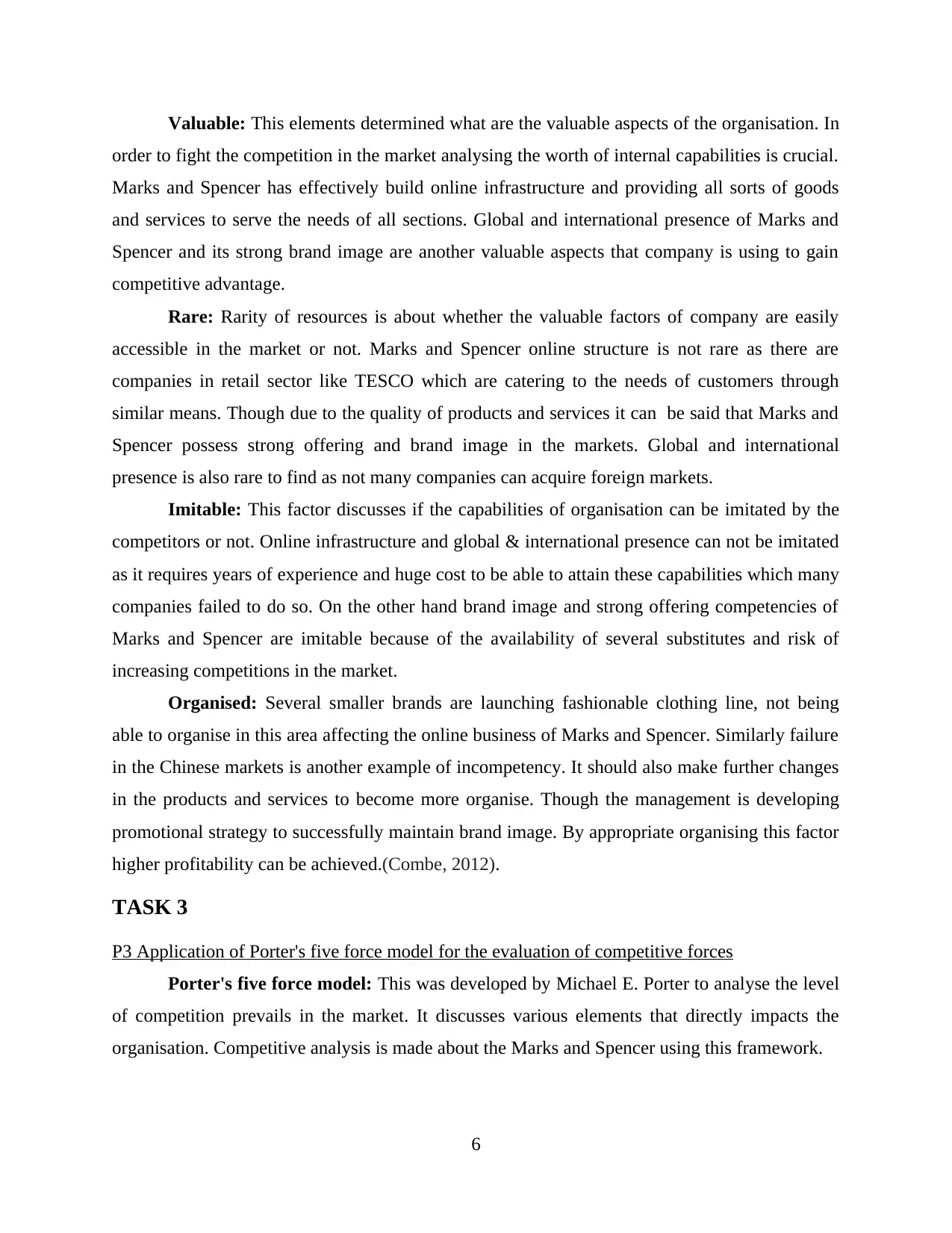
Valuable: This elements determined what are the valuable aspects of the organisation. In
order to fight the competition in the market analysing the worth of internal capabilities is crucial.
Marks and Spencer has effectively build online infrastructure and providing all sorts of goods
and services to serve the needs of all sections. Global and international presence of Marks and
Spencer and its strong brand image are another valuable aspects that company is using to gain
competitive advantage.
Rare: Rarity of resources is about whether the valuable factors of company are easily
accessible in the market or not. Marks and Spencer online structure is not rare as there are
companies in retail sector like TESCO which are catering to the needs of customers through
similar means. Though due to the quality of products and services it can be said that Marks and
Spencer possess strong offering and brand image in the markets. Global and international
presence is also rare to find as not many companies can acquire foreign markets.
Imitable: This factor discusses if the capabilities of organisation can be imitated by the
competitors or not. Online infrastructure and global & international presence can not be imitated
as it requires years of experience and huge cost to be able to attain these capabilities which many
companies failed to do so. On the other hand brand image and strong offering competencies of
Marks and Spencer are imitable because of the availability of several substitutes and risk of
increasing competitions in the market.
Organised: Several smaller brands are launching fashionable clothing line, not being
able to organise in this area affecting the online business of Marks and Spencer. Similarly failure
in the Chinese markets is another example of incompetency. It should also make further changes
in the products and services to become more organise. Though the management is developing
promotional strategy to successfully maintain brand image. By appropriate organising this factor
higher profitability can be achieved.(Combe, 2012).
TASK 3
P3 Application of Porter's five force model for the evaluation of competitive forces
Porter's five force model: This was developed by Michael E. Porter to analyse the level
of competition prevails in the market. It discusses various elements that directly impacts the
organisation. Competitive analysis is made about the Marks and Spencer using this framework.
6
order to fight the competition in the market analysing the worth of internal capabilities is crucial.
Marks and Spencer has effectively build online infrastructure and providing all sorts of goods
and services to serve the needs of all sections. Global and international presence of Marks and
Spencer and its strong brand image are another valuable aspects that company is using to gain
competitive advantage.
Rare: Rarity of resources is about whether the valuable factors of company are easily
accessible in the market or not. Marks and Spencer online structure is not rare as there are
companies in retail sector like TESCO which are catering to the needs of customers through
similar means. Though due to the quality of products and services it can be said that Marks and
Spencer possess strong offering and brand image in the markets. Global and international
presence is also rare to find as not many companies can acquire foreign markets.
Imitable: This factor discusses if the capabilities of organisation can be imitated by the
competitors or not. Online infrastructure and global & international presence can not be imitated
as it requires years of experience and huge cost to be able to attain these capabilities which many
companies failed to do so. On the other hand brand image and strong offering competencies of
Marks and Spencer are imitable because of the availability of several substitutes and risk of
increasing competitions in the market.
Organised: Several smaller brands are launching fashionable clothing line, not being
able to organise in this area affecting the online business of Marks and Spencer. Similarly failure
in the Chinese markets is another example of incompetency. It should also make further changes
in the products and services to become more organise. Though the management is developing
promotional strategy to successfully maintain brand image. By appropriate organising this factor
higher profitability can be achieved.(Combe, 2012).
TASK 3
P3 Application of Porter's five force model for the evaluation of competitive forces
Porter's five force model: This was developed by Michael E. Porter to analyse the level
of competition prevails in the market. It discusses various elements that directly impacts the
organisation. Competitive analysis is made about the Marks and Spencer using this framework.
6
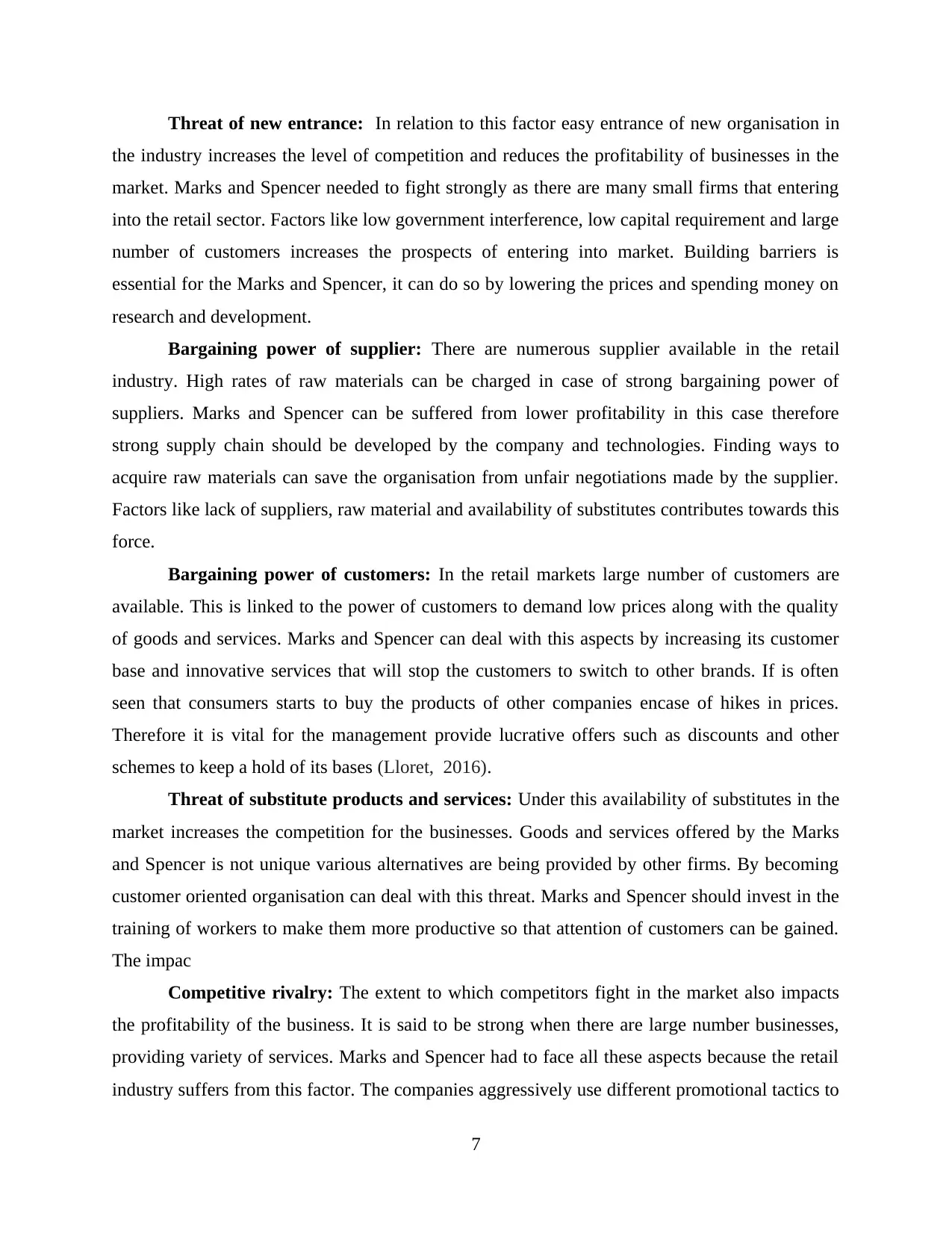
Threat of new entrance: In relation to this factor easy entrance of new organisation in
the industry increases the level of competition and reduces the profitability of businesses in the
market. Marks and Spencer needed to fight strongly as there are many small firms that entering
into the retail sector. Factors like low government interference, low capital requirement and large
number of customers increases the prospects of entering into market. Building barriers is
essential for the Marks and Spencer, it can do so by lowering the prices and spending money on
research and development.
Bargaining power of supplier: There are numerous supplier available in the retail
industry. High rates of raw materials can be charged in case of strong bargaining power of
suppliers. Marks and Spencer can be suffered from lower profitability in this case therefore
strong supply chain should be developed by the company and technologies. Finding ways to
acquire raw materials can save the organisation from unfair negotiations made by the supplier.
Factors like lack of suppliers, raw material and availability of substitutes contributes towards this
force.
Bargaining power of customers: In the retail markets large number of customers are
available. This is linked to the power of customers to demand low prices along with the quality
of goods and services. Marks and Spencer can deal with this aspects by increasing its customer
base and innovative services that will stop the customers to switch to other brands. If is often
seen that consumers starts to buy the products of other companies encase of hikes in prices.
Therefore it is vital for the management provide lucrative offers such as discounts and other
schemes to keep a hold of its bases (Lloret, 2016).
Threat of substitute products and services: Under this availability of substitutes in the
market increases the competition for the businesses. Goods and services offered by the Marks
and Spencer is not unique various alternatives are being provided by other firms. By becoming
customer oriented organisation can deal with this threat. Marks and Spencer should invest in the
training of workers to make them more productive so that attention of customers can be gained.
The impac
Competitive rivalry: The extent to which competitors fight in the market also impacts
the profitability of the business. It is said to be strong when there are large number businesses,
providing variety of services. Marks and Spencer had to face all these aspects because the retail
industry suffers from this factor. The companies aggressively use different promotional tactics to
7
the industry increases the level of competition and reduces the profitability of businesses in the
market. Marks and Spencer needed to fight strongly as there are many small firms that entering
into the retail sector. Factors like low government interference, low capital requirement and large
number of customers increases the prospects of entering into market. Building barriers is
essential for the Marks and Spencer, it can do so by lowering the prices and spending money on
research and development.
Bargaining power of supplier: There are numerous supplier available in the retail
industry. High rates of raw materials can be charged in case of strong bargaining power of
suppliers. Marks and Spencer can be suffered from lower profitability in this case therefore
strong supply chain should be developed by the company and technologies. Finding ways to
acquire raw materials can save the organisation from unfair negotiations made by the supplier.
Factors like lack of suppliers, raw material and availability of substitutes contributes towards this
force.
Bargaining power of customers: In the retail markets large number of customers are
available. This is linked to the power of customers to demand low prices along with the quality
of goods and services. Marks and Spencer can deal with this aspects by increasing its customer
base and innovative services that will stop the customers to switch to other brands. If is often
seen that consumers starts to buy the products of other companies encase of hikes in prices.
Therefore it is vital for the management provide lucrative offers such as discounts and other
schemes to keep a hold of its bases (Lloret, 2016).
Threat of substitute products and services: Under this availability of substitutes in the
market increases the competition for the businesses. Goods and services offered by the Marks
and Spencer is not unique various alternatives are being provided by other firms. By becoming
customer oriented organisation can deal with this threat. Marks and Spencer should invest in the
training of workers to make them more productive so that attention of customers can be gained.
The impac
Competitive rivalry: The extent to which competitors fight in the market also impacts
the profitability of the business. It is said to be strong when there are large number businesses,
providing variety of services. Marks and Spencer had to face all these aspects because the retail
industry suffers from this factor. The companies aggressively use different promotional tactics to
7
Secure Best Marks with AI Grader
Need help grading? Try our AI Grader for instant feedback on your assignments.
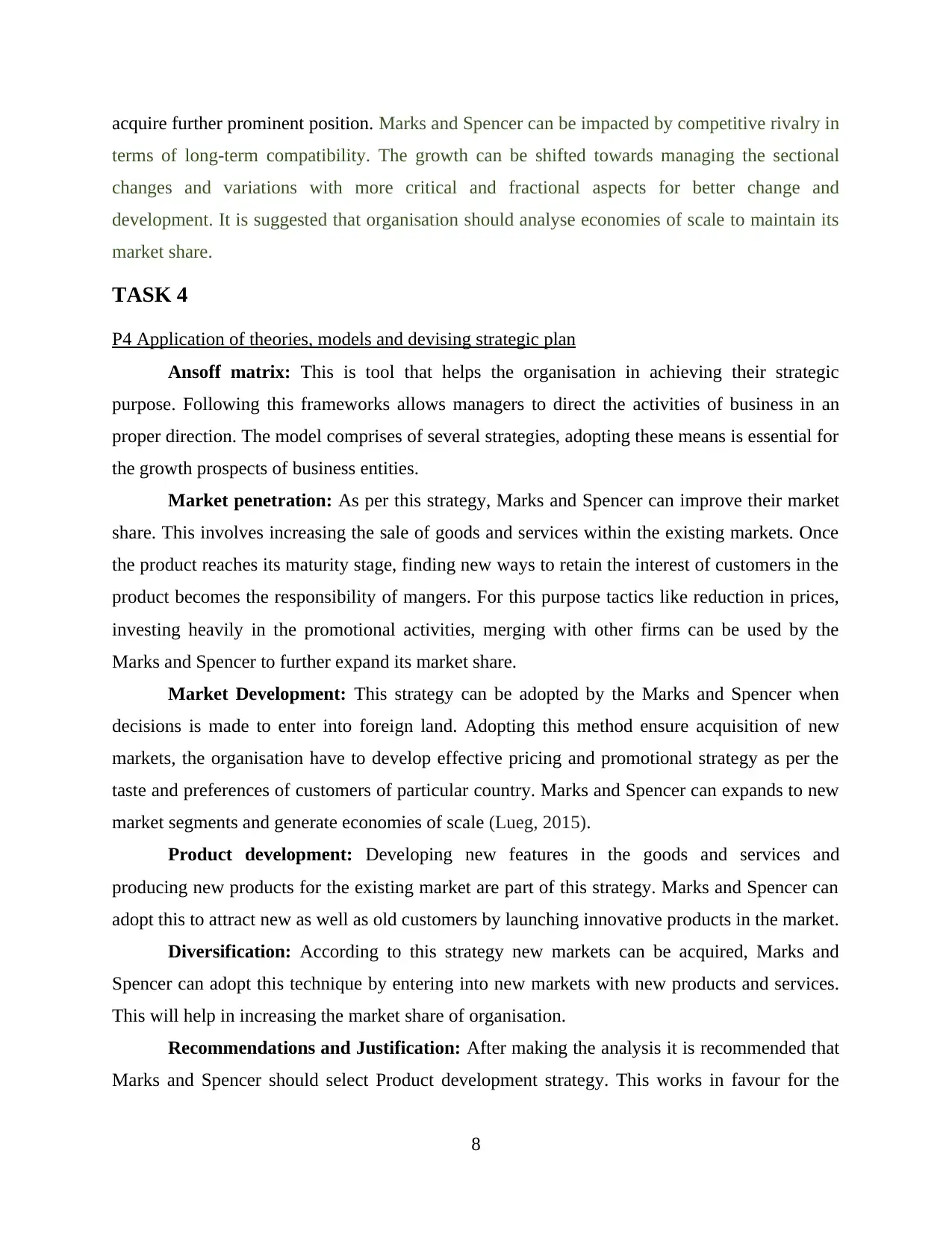
acquire further prominent position. Marks and Spencer can be impacted by competitive rivalry in
terms of long-term compatibility. The growth can be shifted towards managing the sectional
changes and variations with more critical and fractional aspects for better change and
development. It is suggested that organisation should analyse economies of scale to maintain its
market share.
TASK 4
P4 Application of theories, models and devising strategic plan
Ansoff matrix: This is tool that helps the organisation in achieving their strategic
purpose. Following this frameworks allows managers to direct the activities of business in an
proper direction. The model comprises of several strategies, adopting these means is essential for
the growth prospects of business entities.
Market penetration: As per this strategy, Marks and Spencer can improve their market
share. This involves increasing the sale of goods and services within the existing markets. Once
the product reaches its maturity stage, finding new ways to retain the interest of customers in the
product becomes the responsibility of mangers. For this purpose tactics like reduction in prices,
investing heavily in the promotional activities, merging with other firms can be used by the
Marks and Spencer to further expand its market share.
Market Development: This strategy can be adopted by the Marks and Spencer when
decisions is made to enter into foreign land. Adopting this method ensure acquisition of new
markets, the organisation have to develop effective pricing and promotional strategy as per the
taste and preferences of customers of particular country. Marks and Spencer can expands to new
market segments and generate economies of scale (Lueg, 2015).
Product development: Developing new features in the goods and services and
producing new products for the existing market are part of this strategy. Marks and Spencer can
adopt this to attract new as well as old customers by launching innovative products in the market.
Diversification: According to this strategy new markets can be acquired, Marks and
Spencer can adopt this technique by entering into new markets with new products and services.
This will help in increasing the market share of organisation.
Recommendations and Justification: After making the analysis it is recommended that
Marks and Spencer should select Product development strategy. This works in favour for the
8
terms of long-term compatibility. The growth can be shifted towards managing the sectional
changes and variations with more critical and fractional aspects for better change and
development. It is suggested that organisation should analyse economies of scale to maintain its
market share.
TASK 4
P4 Application of theories, models and devising strategic plan
Ansoff matrix: This is tool that helps the organisation in achieving their strategic
purpose. Following this frameworks allows managers to direct the activities of business in an
proper direction. The model comprises of several strategies, adopting these means is essential for
the growth prospects of business entities.
Market penetration: As per this strategy, Marks and Spencer can improve their market
share. This involves increasing the sale of goods and services within the existing markets. Once
the product reaches its maturity stage, finding new ways to retain the interest of customers in the
product becomes the responsibility of mangers. For this purpose tactics like reduction in prices,
investing heavily in the promotional activities, merging with other firms can be used by the
Marks and Spencer to further expand its market share.
Market Development: This strategy can be adopted by the Marks and Spencer when
decisions is made to enter into foreign land. Adopting this method ensure acquisition of new
markets, the organisation have to develop effective pricing and promotional strategy as per the
taste and preferences of customers of particular country. Marks and Spencer can expands to new
market segments and generate economies of scale (Lueg, 2015).
Product development: Developing new features in the goods and services and
producing new products for the existing market are part of this strategy. Marks and Spencer can
adopt this to attract new as well as old customers by launching innovative products in the market.
Diversification: According to this strategy new markets can be acquired, Marks and
Spencer can adopt this technique by entering into new markets with new products and services.
This will help in increasing the market share of organisation.
Recommendations and Justification: After making the analysis it is recommended that
Marks and Spencer should select Product development strategy. This works in favour for the
8
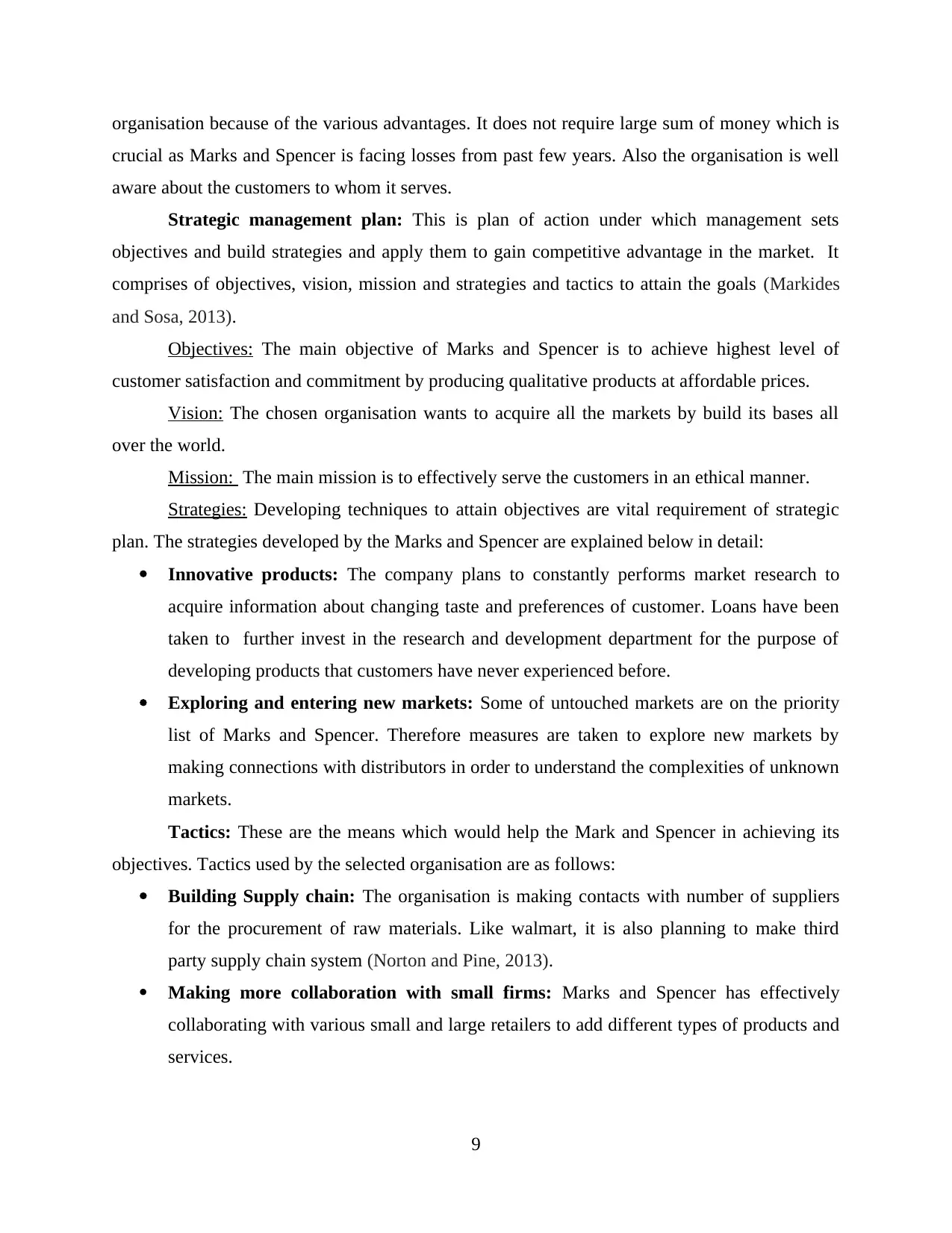
organisation because of the various advantages. It does not require large sum of money which is
crucial as Marks and Spencer is facing losses from past few years. Also the organisation is well
aware about the customers to whom it serves.
Strategic management plan: This is plan of action under which management sets
objectives and build strategies and apply them to gain competitive advantage in the market. It
comprises of objectives, vision, mission and strategies and tactics to attain the goals (Markides
and Sosa, 2013).
Objectives: The main objective of Marks and Spencer is to achieve highest level of
customer satisfaction and commitment by producing qualitative products at affordable prices.
Vision: The chosen organisation wants to acquire all the markets by build its bases all
over the world.
Mission: The main mission is to effectively serve the customers in an ethical manner.
Strategies: Developing techniques to attain objectives are vital requirement of strategic
plan. The strategies developed by the Marks and Spencer are explained below in detail:
Innovative products: The company plans to constantly performs market research to
acquire information about changing taste and preferences of customer. Loans have been
taken to further invest in the research and development department for the purpose of
developing products that customers have never experienced before.
Exploring and entering new markets: Some of untouched markets are on the priority
list of Marks and Spencer. Therefore measures are taken to explore new markets by
making connections with distributors in order to understand the complexities of unknown
markets.
Tactics: These are the means which would help the Mark and Spencer in achieving its
objectives. Tactics used by the selected organisation are as follows:
Building Supply chain: The organisation is making contacts with number of suppliers
for the procurement of raw materials. Like walmart, it is also planning to make third
party supply chain system (Norton and Pine, 2013).
Making more collaboration with small firms: Marks and Spencer has effectively
collaborating with various small and large retailers to add different types of products and
services.
9
crucial as Marks and Spencer is facing losses from past few years. Also the organisation is well
aware about the customers to whom it serves.
Strategic management plan: This is plan of action under which management sets
objectives and build strategies and apply them to gain competitive advantage in the market. It
comprises of objectives, vision, mission and strategies and tactics to attain the goals (Markides
and Sosa, 2013).
Objectives: The main objective of Marks and Spencer is to achieve highest level of
customer satisfaction and commitment by producing qualitative products at affordable prices.
Vision: The chosen organisation wants to acquire all the markets by build its bases all
over the world.
Mission: The main mission is to effectively serve the customers in an ethical manner.
Strategies: Developing techniques to attain objectives are vital requirement of strategic
plan. The strategies developed by the Marks and Spencer are explained below in detail:
Innovative products: The company plans to constantly performs market research to
acquire information about changing taste and preferences of customer. Loans have been
taken to further invest in the research and development department for the purpose of
developing products that customers have never experienced before.
Exploring and entering new markets: Some of untouched markets are on the priority
list of Marks and Spencer. Therefore measures are taken to explore new markets by
making connections with distributors in order to understand the complexities of unknown
markets.
Tactics: These are the means which would help the Mark and Spencer in achieving its
objectives. Tactics used by the selected organisation are as follows:
Building Supply chain: The organisation is making contacts with number of suppliers
for the procurement of raw materials. Like walmart, it is also planning to make third
party supply chain system (Norton and Pine, 2013).
Making more collaboration with small firms: Marks and Spencer has effectively
collaborating with various small and large retailers to add different types of products and
services.
9
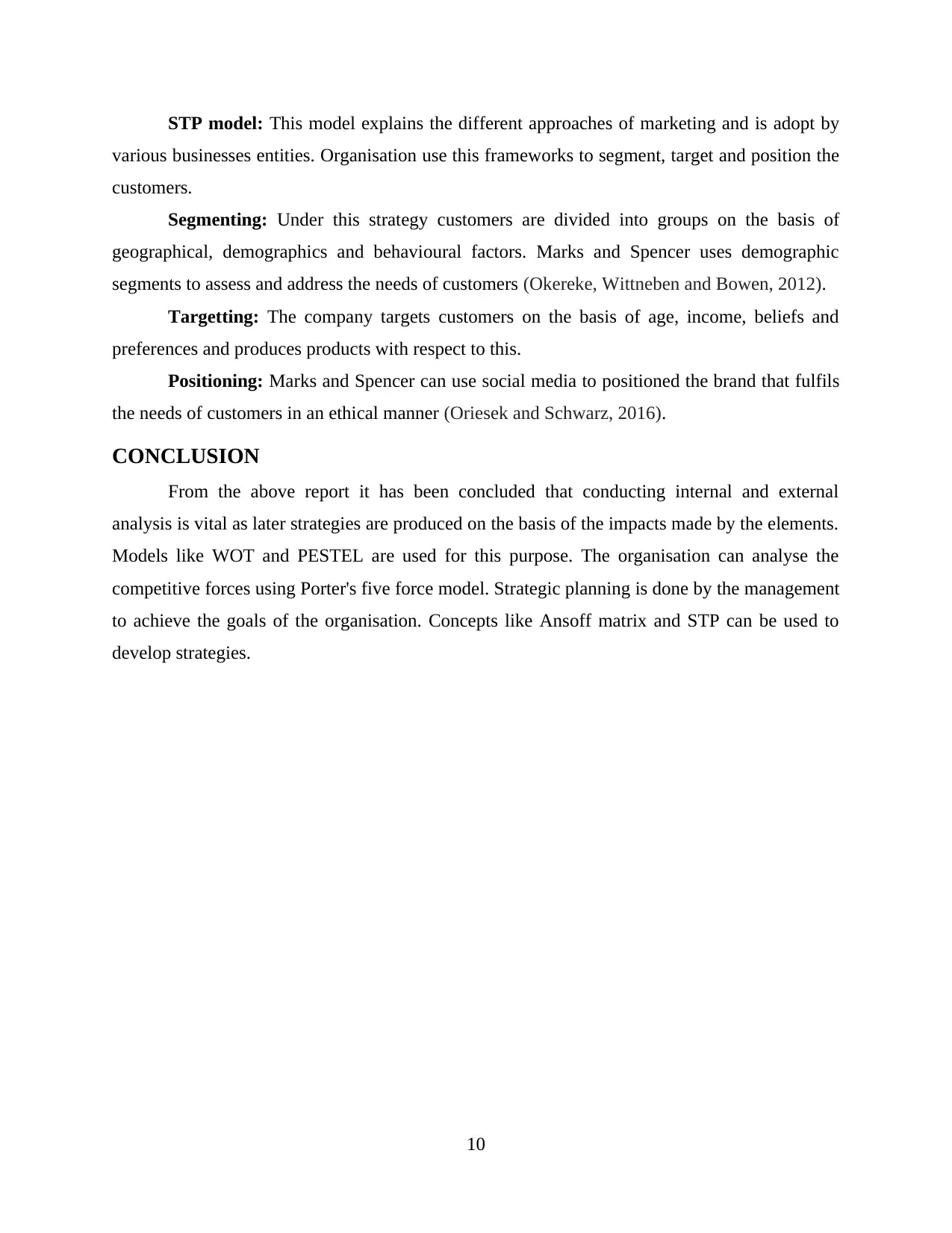
STP model: This model explains the different approaches of marketing and is adopt by
various businesses entities. Organisation use this frameworks to segment, target and position the
customers.
Segmenting: Under this strategy customers are divided into groups on the basis of
geographical, demographics and behavioural factors. Marks and Spencer uses demographic
segments to assess and address the needs of customers (Okereke, Wittneben and Bowen, 2012).
Targetting: The company targets customers on the basis of age, income, beliefs and
preferences and produces products with respect to this.
Positioning: Marks and Spencer can use social media to positioned the brand that fulfils
the needs of customers in an ethical manner (Oriesek and Schwarz, 2016).
CONCLUSION
From the above report it has been concluded that conducting internal and external
analysis is vital as later strategies are produced on the basis of the impacts made by the elements.
Models like WOT and PESTEL are used for this purpose. The organisation can analyse the
competitive forces using Porter's five force model. Strategic planning is done by the management
to achieve the goals of the organisation. Concepts like Ansoff matrix and STP can be used to
develop strategies.
10
various businesses entities. Organisation use this frameworks to segment, target and position the
customers.
Segmenting: Under this strategy customers are divided into groups on the basis of
geographical, demographics and behavioural factors. Marks and Spencer uses demographic
segments to assess and address the needs of customers (Okereke, Wittneben and Bowen, 2012).
Targetting: The company targets customers on the basis of age, income, beliefs and
preferences and produces products with respect to this.
Positioning: Marks and Spencer can use social media to positioned the brand that fulfils
the needs of customers in an ethical manner (Oriesek and Schwarz, 2016).
CONCLUSION
From the above report it has been concluded that conducting internal and external
analysis is vital as later strategies are produced on the basis of the impacts made by the elements.
Models like WOT and PESTEL are used for this purpose. The organisation can analyse the
competitive forces using Porter's five force model. Strategic planning is done by the management
to achieve the goals of the organisation. Concepts like Ansoff matrix and STP can be used to
develop strategies.
10
Paraphrase This Document
Need a fresh take? Get an instant paraphrase of this document with our AI Paraphraser
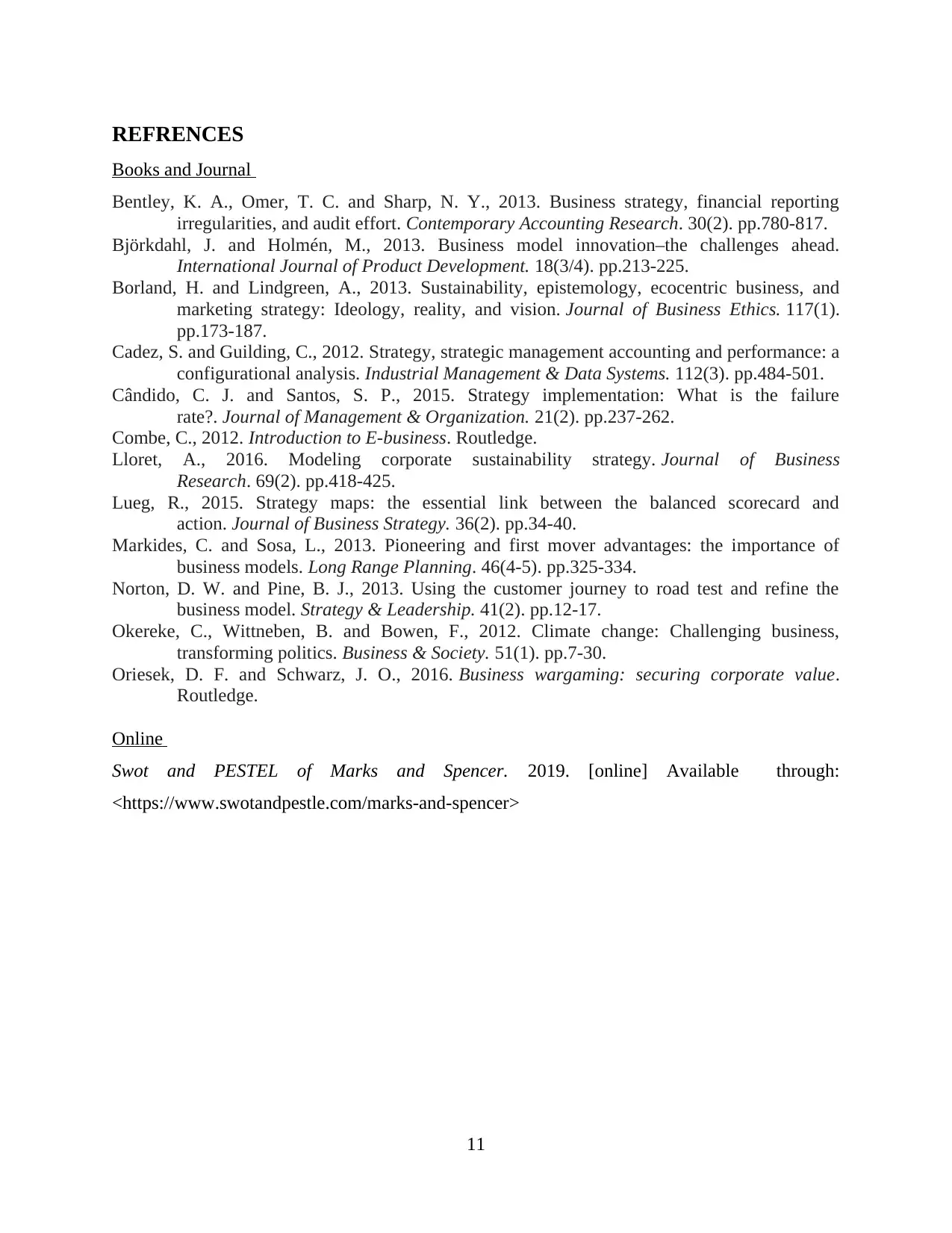
REFRENCES
Books and Journal
Bentley, K. A., Omer, T. C. and Sharp, N. Y., 2013. Business strategy, financial reporting
irregularities, and audit effort. Contemporary Accounting Research. 30(2). pp.780-817.
Björkdahl, J. and Holmén, M., 2013. Business model innovation–the challenges ahead.
International Journal of Product Development. 18(3/4). pp.213-225.
Borland, H. and Lindgreen, A., 2013. Sustainability, epistemology, ecocentric business, and
marketing strategy: Ideology, reality, and vision. Journal of Business Ethics. 117(1).
pp.173-187.
Cadez, S. and Guilding, C., 2012. Strategy, strategic management accounting and performance: a
configurational analysis. Industrial Management & Data Systems. 112(3). pp.484-501.
Cândido, C. J. and Santos, S. P., 2015. Strategy implementation: What is the failure
rate?. Journal of Management & Organization. 21(2). pp.237-262.
Combe, C., 2012. Introduction to E-business. Routledge.
Lloret, A., 2016. Modeling corporate sustainability strategy. Journal of Business
Research. 69(2). pp.418-425.
Lueg, R., 2015. Strategy maps: the essential link between the balanced scorecard and
action. Journal of Business Strategy. 36(2). pp.34-40.
Markides, C. and Sosa, L., 2013. Pioneering and first mover advantages: the importance of
business models. Long Range Planning. 46(4-5). pp.325-334.
Norton, D. W. and Pine, B. J., 2013. Using the customer journey to road test and refine the
business model. Strategy & Leadership. 41(2). pp.12-17.
Okereke, C., Wittneben, B. and Bowen, F., 2012. Climate change: Challenging business,
transforming politics. Business & Society. 51(1). pp.7-30.
Oriesek, D. F. and Schwarz, J. O., 2016. Business wargaming: securing corporate value.
Routledge.
Online
Swot and PESTEL of Marks and Spencer. 2019. [online] Available through:
<https://www.swotandpestle.com/marks-and-spencer>
11
Books and Journal
Bentley, K. A., Omer, T. C. and Sharp, N. Y., 2013. Business strategy, financial reporting
irregularities, and audit effort. Contemporary Accounting Research. 30(2). pp.780-817.
Björkdahl, J. and Holmén, M., 2013. Business model innovation–the challenges ahead.
International Journal of Product Development. 18(3/4). pp.213-225.
Borland, H. and Lindgreen, A., 2013. Sustainability, epistemology, ecocentric business, and
marketing strategy: Ideology, reality, and vision. Journal of Business Ethics. 117(1).
pp.173-187.
Cadez, S. and Guilding, C., 2012. Strategy, strategic management accounting and performance: a
configurational analysis. Industrial Management & Data Systems. 112(3). pp.484-501.
Cândido, C. J. and Santos, S. P., 2015. Strategy implementation: What is the failure
rate?. Journal of Management & Organization. 21(2). pp.237-262.
Combe, C., 2012. Introduction to E-business. Routledge.
Lloret, A., 2016. Modeling corporate sustainability strategy. Journal of Business
Research. 69(2). pp.418-425.
Lueg, R., 2015. Strategy maps: the essential link between the balanced scorecard and
action. Journal of Business Strategy. 36(2). pp.34-40.
Markides, C. and Sosa, L., 2013. Pioneering and first mover advantages: the importance of
business models. Long Range Planning. 46(4-5). pp.325-334.
Norton, D. W. and Pine, B. J., 2013. Using the customer journey to road test and refine the
business model. Strategy & Leadership. 41(2). pp.12-17.
Okereke, C., Wittneben, B. and Bowen, F., 2012. Climate change: Challenging business,
transforming politics. Business & Society. 51(1). pp.7-30.
Oriesek, D. F. and Schwarz, J. O., 2016. Business wargaming: securing corporate value.
Routledge.
Online
Swot and PESTEL of Marks and Spencer. 2019. [online] Available through:
<https://www.swotandpestle.com/marks-and-spencer>
11
1 out of 14
Related Documents
Your All-in-One AI-Powered Toolkit for Academic Success.
+13062052269
info@desklib.com
Available 24*7 on WhatsApp / Email
![[object Object]](/_next/static/media/star-bottom.7253800d.svg)
Unlock your academic potential
© 2024 | Zucol Services PVT LTD | All rights reserved.




